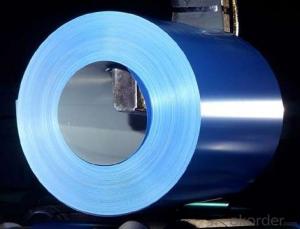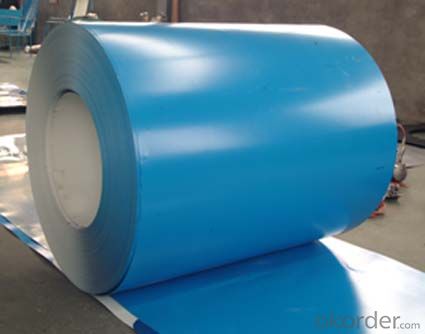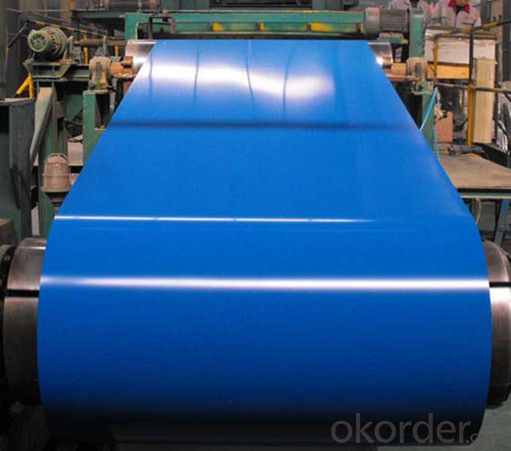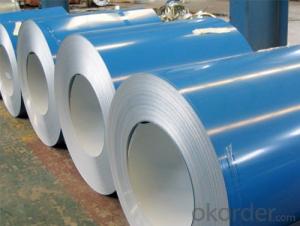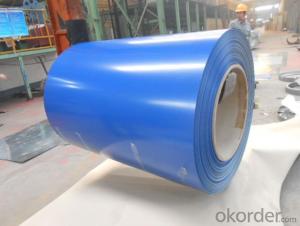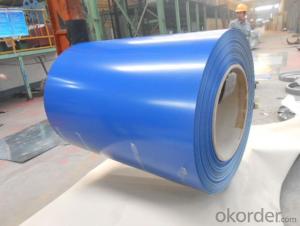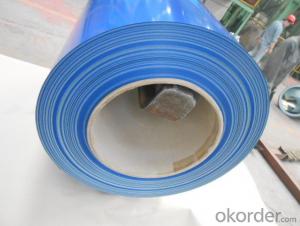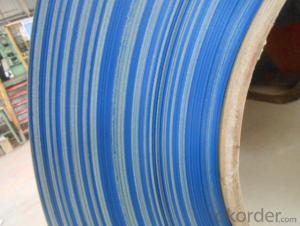Pre-Painted Steel Coil Blue Color Prime Quality
- Loading Port:
- Tianjin
- Payment Terms:
- TT OR LC
- Min Order Qty:
- 50 m.t.
- Supply Capability:
- 10000 m.t./month
OKorder Service Pledge
OKorder Financial Service
You Might Also Like
1. Pre-Painted Galvalume Steel Coil Description:
With GI as base material, after pretreatment (degrease and chemical treatment ) and liquid dope with several layers of color, then after firing and cooling, finally the plate steel is called pre-painted galvanized (aluzinc) steel. Pre-painted galvanized steel is good capable of decoration, molding, corrosion resistance. It generally displays superior workability, durability and weather resistance.
2.Main Features of the Pre-Painted Galvalume Steel Coil:
• Excellent process capability
• Smooth and flat surface
• Workability, durability
• Excellent heat resistance performance
• High strength
• Good formability
• Good visual effect
3.Pre-Painted Galvalume Steel Coil Images
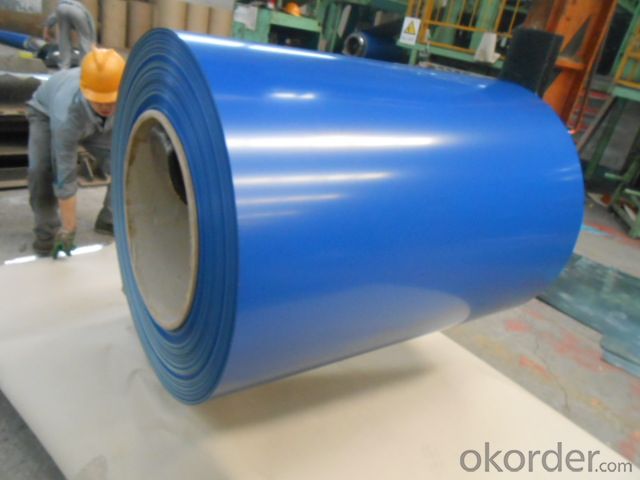
4.Pre-Painted Galvalume Steel Coil Specification
Standard: AISI, ASTM, BS, DIN, GB, JIS
Grade: DX51D, DX52D
Thickness: 0.17-2.0mm
Brand Name: KMRLON
Model Number: coil
Type: Steel Coil
Technique: Cold Rolled
Surface Treatment: Coated
Application: Boiler Plate
Special Use: High-strength Steel Plate
Width: 20-1250mm
Length: customized
commoidty: pre-painted galvanized steel coil
Thickness: 0.13-4.0mm
width: 20-1250mm
zinc coating: 40-180g/m2
printing thickness: top side: 20+/-5 microns, back side: 5-7 microns
color: all RAL color
surface treatment: color coated
coil weight: 4-7 tons
coil ID: 508/610mm
packaging: standard seaworthy packing
5.FAQ of Pre-Painted Galvalume Steel Coil
1. What’s the application of this product?
Roof, roof structure, surface sheet of balcony, frame of window, etc.
2. What’s the brand of the paint?
We use the best brand of all of the word—AKZO.
3. How to guarantee the quality of the products?
We have established the international advanced quality management system,every link from raw material to final product we have strict quality test;We resolutely put an end to unqualified products flowing into the market. At the same time, we will provide necessary follow-up service assurance.
4. How long can we receive the product after purchase?
Usually within thirty working days after receiving buyer’s advance payment or LC. We will arrange the factory manufacturing as soon as possible. The cargo readiness usually takes 15-25 days, but the shipment will depend on the vessel situation.
- Q: What are the factors affecting the lifespan of steel coils?
- There are several factors that can affect the lifespan of steel coils, including the quality of the steel used, the level of protection against corrosion, the storage and handling conditions, the frequency and severity of mechanical stress, and the effectiveness of maintenance and preservation practices.
- Q: How are steel coils used in the production of bridges and infrastructure?
- Steel coils are an essential component in the production of bridges and infrastructure. These coils are made from steel, which is a strong and durable material that can withstand heavy loads and harsh environmental conditions. In bridge construction, steel coils are used to manufacture the structural components such as beams, girders, and columns. These components provide the necessary strength and support to the bridge, allowing it to carry the weight of vehicles, pedestrians, and other loads. Steel coils are rolled into the desired shape, cut to the required length, and then welded or bolted together to create these structural elements. Additionally, steel coils are also used in the fabrication of bridge decks, which are the roadways or walkways on the bridge. These coils are processed to form steel plates, which are then assembled and secured onto the bridge structure. The steel plates provide a smooth and durable surface for vehicles and pedestrians to travel on. In terms of infrastructure, steel coils play a vital role in the construction of various structures such as buildings, stadiums, and industrial facilities. They are used to fabricate the primary support systems, including columns, beams, and trusses, which provide the necessary strength and stability to these structures. Steel coils are also used to create roofing and cladding systems, ensuring protection against weather elements and enhancing the overall aesthetics of the infrastructure. Furthermore, steel coils are often used in the production of reinforcing bars, commonly known as rebar. Rebar is essential for reinforcing concrete structures such as foundations, walls, and slabs. These coils are processed into various sizes and shapes, and then embedded within the concrete to increase its tensile strength and prevent cracking or collapsing under heavy loads. Overall, steel coils are a critical component in the production of bridges and infrastructure. Their strength, durability, and versatility make them an ideal material for constructing safe and reliable structures that can withstand the test of time.
- Q: How are steel coils used in the manufacturing of aerospace components?
- Steel coils are used in the manufacturing of aerospace components as they provide a reliable and durable material for various applications. The coils are typically cut and formed into different shapes to create components like structural supports, brackets, and fasteners. These components play crucial roles in the construction and assembly of aerospace systems, ensuring strength, stability, and safety in the final products.
- Q: I'm doing a commercial for chemistry and I need to know any kind of chemistry dealing with Callaway Big Bertha Irons. I know they are stainless steel but any more info would help out! Thank you! :)
- Stainless steel is a mixture of metals, each metal is included in order to make up for each others weaknesses. Each metal is included due to a property that is benificial in some way, for instance Chromium is included because it makes the stainless steel 'stainless'. In chemistry a mixture of metals, stainless steel, is called an alloy.
- Q: What are the dimensions of steel coils used in the transportation equipment industry?
- The dimensions of steel coils utilized in the transportation equipment sector may differ according to specific demands and applications. Nevertheless, there exist some prevalent measurements that are extensively employed. Typically, the width of steel coils used in the transportation equipment industry ranges from 600mm to 2000mm (24 to 78 inches). This width is selected to ensure compatibility with the machinery and equipment employed in transportation, such as trucks, trailers, and railcars. The thickness of steel coils exhibits significant variation depending on the specific application and desired material strength. However, common thickness ranges for steel coils in the transportation equipment industry generally fall between 0.5mm and 6mm (0.02 to 0.24 inches). The inner diameter of steel coils utilized in the transportation equipment industry is typically standardized at either 508mm (20 inches) or 610mm (24 inches). This standardization facilitates easy handling and compatibility with industry machinery. The outer diameter of steel coils can differ depending on the coil's width and thickness. Nonetheless, typical outer diameter ranges for steel coils in the transportation equipment industry generally span from 1000mm to 2200mm (39 to 87 inches). It should be recognized that these dimensions are not fixed and can be tailored to specific requirements and applications within the transportation equipment industry.
- Q: How are steel coils processed for different levels of hardness?
- Different levels of hardness can be attained in steel coils using a variety of methods. One common approach is heat treatment, in which the coils are heated to a specific temperature and then rapidly cooled to modify their microstructure and achieve the desired hardness. The heat treatment process can encompass quenching, tempering, or annealing, depending on the desired hardness level. Quenching involves quick cooling of the coils in a liquid medium like water or oil to achieve a high hardness level. On the other hand, tempering requires reheating the coils to a lower temperature and gradually cooling them to attain a desired balance between hardness and toughness. Annealing, on the other hand, involves heating the coils to a specific temperature followed by slow cooling to release internal stresses and obtain a softer and more malleable material. Additionally, mechanical processes like cold rolling or cold working can be employed to enhance the hardness of steel coils. These processes involve applying compressive forces to the coils, causing the material to deform and resulting in increased hardness. Overall, achieving different hardness levels in steel coils requires meticulous control of temperature, cooling rate, and mechanical forces to obtain the desired properties for specific applications.
- Q: What are the common applications of steel coils?
- Steel coils have a wide range of applications, commonly used in industries such as automotive, construction, manufacturing, and appliances. They are utilized for making various products including automobiles, pipes, electrical appliances, roofing, and packaging materials.
- Q: I'm wondering if steel casings are bad for a 1911. I know that an AK-47 will eat up steel casings all day long, but steel casings are bad for, and can be hard on an AR-15. I only have brass for my AR and that will never change. I'm curious as to how a 1911 fairs with steel casings. Is it bad for the gun or does it not matter? I'm asking because steel cased rounds seem to be the only readily available ammo these days. Thanks
- This better placed in the hunting section of sports. That is the area for gun questions. I've never used that Russian stuff in my guns. I would stick with brass or Aluminum Blaser ammo.
- Q: What are the different types of steel grades used for coil production?
- There are various types of steel grades used for coil production, including carbon steel, stainless steel, high-strength low-alloy (HSLA) steel, and advanced high-strength steel (AHSS). Each grade has its own unique properties and is chosen based on the specific requirements of the application.
- Q: How are steel coils used in the manufacturing of crash structures?
- Steel coils are used in the manufacturing of crash structures as they provide high strength and durability, making them ideal for absorbing impact energy and protecting occupants in case of a collision. The coils are typically shaped and formed into specific components of the crash structure, such as side sills or front rails, which are then integrated into the vehicle's frame. This ensures that the vehicle has the necessary rigidity and structural integrity to withstand and mitigate the forces generated during a crash, thereby enhancing the safety of the occupants.
Send your message to us
Pre-Painted Steel Coil Blue Color Prime Quality
- Loading Port:
- Tianjin
- Payment Terms:
- TT OR LC
- Min Order Qty:
- 50 m.t.
- Supply Capability:
- 10000 m.t./month
OKorder Service Pledge
OKorder Financial Service
Similar products
Hot products
Hot Searches
Related keywords
